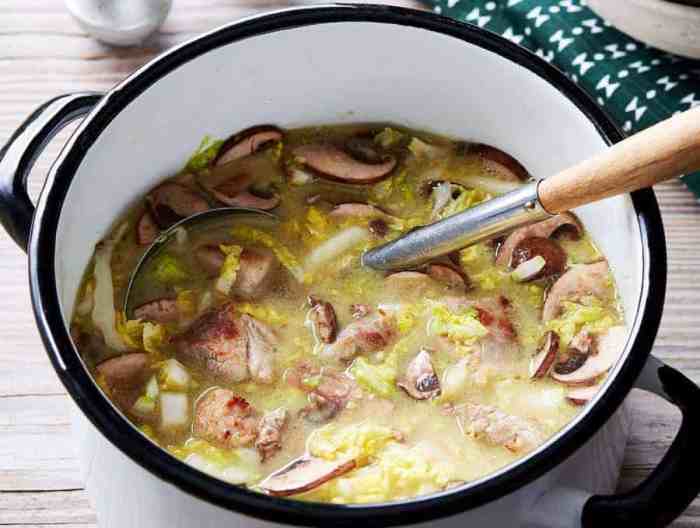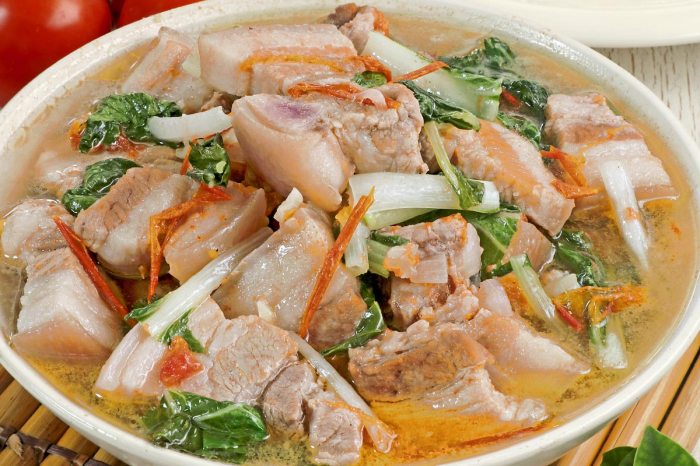Popular Pork Soup Variations

Source: twosleevers.com
Pork in soup recipes – Pork soup, a culinary staple across numerous cultures, boasts a remarkable diversity in its recipes. From hearty broths to lighter, more delicate variations, the versatility of pork lends itself beautifully to a wide range of flavors and textures. This section explores several popular pork soup recipes, delves into the nuances of pork bone broth preparation, and examines the impact of different pork cuts on the final product.
Popular Pork Soup Recipes from Around the World
The following table highlights a selection of popular pork soup recipes, showcasing the global reach and adaptability of this comforting dish.
| Name | Cuisine | Key Ingredients | Brief Description |
|---|---|---|---|
| Pozole | Mexican | Pork, hominy, chiles, onions, garlic | A hearty and flavorful stew, often served with various toppings like shredded lettuce, radishes, and lime. |
| Tonkotsu Ramen | Japanese | Pork bones, soy sauce, mirin, dashi | A rich and creamy broth made by simmering pork bones for extended periods, resulting in a deeply flavorful soup. |
| Sinigang | Filipino | Pork, tamarind broth, vegetables (e.g., kangkong, string beans) | A sour and savory soup, the tamarind broth provides a unique tanginess that complements the pork beautifully. |
| Jiaozi Soup | Chinese | Pork dumplings, broth, vegetables (e.g., bok choy, mushrooms) | A comforting soup featuring flavorful pork dumplings in a light and savory broth. |
| Kapusta | Polish | Pork ribs, sauerkraut, potatoes, onions | A hearty and flavorful soup featuring tender pork ribs and tangy sauerkraut. |
Unique Pork Bone Broth Recipes
The preparation and resulting flavor profiles of pork bone broth can vary significantly depending on the ingredients and cooking methods employed. Here are three distinct approaches:
- Basic Pork Bone Broth: This simple broth focuses on the inherent flavor of the bones. Ingredients include pork bones, water, onions, carrots, and celery. Simmered for at least 6 hours, it yields a clean and subtly sweet broth.
- Spicy Pork Bone Broth: This version incorporates aromatics like ginger, garlic, chilies, and star anise to create a bolder, more complex flavor profile. The longer simmering time allows the spices to infuse the broth fully.
- Savory Pork Bone Broth with Vegetables: This richer broth includes a wider array of vegetables such as leeks, mushrooms, and parsnips in addition to the standard aromatics. The added vegetables provide depth and complexity to the flavor.
Variations in Pork Cuts for Soup
The choice of pork cut significantly influences the texture and flavor of the resulting soup. Different cuts offer unique characteristics:
- Pork Shoulder: This cut is known for its rich flavor and tender texture after long cooking. Ideal for slow-cooked soups, it breaks down easily, contributing to a hearty broth.
- Pork Ribs: Ribs offer a more robust flavor and tender meat when slow-cooked or braised. They provide a substantial element to the soup, often falling off the bone.
- Pork Belly: Pork belly, with its high fat content, contributes richness and depth of flavor. It renders beautifully during long cooking, adding body and a luxurious mouthfeel to the soup.
Pork Soup Recipe Ingredients and Substitutions: Pork In Soup Recipes
Understanding the role of each ingredient in pork soup is crucial for achieving the desired flavor and texture. This section details common ingredients, explores possible substitutions, and discusses the impact of spices and herbs.
Common Pork Soup Ingredients, Pork in soup recipes
Pork soup recipes commonly incorporate ingredients from several categories:
- Protein: Pork (various cuts), chicken (as a substitute).
- Vegetables: Onions, carrots, celery, potatoes, cabbage, greens (e.g., kale, spinach).
- Spices and Herbs: Bay leaves, black peppercorns, thyme, rosemary, garlic, ginger.
- Liquids: Water, broth (chicken or pork), wine (optional).
- Other: Noodles, dumplings, rice (as thickeners or additions).
Ingredient Substitutions
Dietary restrictions or ingredient availability may necessitate substitutions. The following table provides options and their potential impact:
| Ingredient | Substitution | Impact on Flavor | Impact on Texture |
|---|---|---|---|
| Pork | Chicken | Lighter, less rich flavor | Similar texture |
| Potatoes | Sweet potatoes | Sweeter, earthier flavor | Similar texture |
| Cabbage | Kale | Slightly bitter, more robust flavor | Slightly tougher texture |
| Soy Sauce | Coconut aminos | Subtly sweeter, less salty | No significant impact |
The Role of Spices and Herbs
Spices and herbs play a vital role in shaping the flavor profile of pork soup. Combinations like thyme and rosemary offer an earthy, herbaceous note, while ginger and garlic provide warmth and pungency. Experimentation with different spice blends can yield unique and exciting results.
Pork Soup Cooking Methods and Techniques
Several cooking methods can be employed to prepare pork soup, each offering distinct advantages and disadvantages. This section compares different methods, provides a step-by-step guide for a basic pork and vegetable soup, and details the importance of browning the pork.
Comparing Cooking Methods
The choice of cooking method depends on factors such as time constraints and desired texture.
- Slow Cooking: Produces exceptionally tender pork and a deeply flavorful broth, but requires significant cooking time.
- Pressure Cooking: Shortens cooking time considerably while maintaining tenderness, but may not yield the same depth of flavor as slow cooking.
- Stovetop Simmering: Offers good control over the cooking process and allows for easy adjustments, but requires more attention and time compared to pressure cooking.
Step-by-Step Guide for Basic Pork and Vegetable Soup

Source: tasteofhome.com
Pork adds a rich depth of flavor to many soups, particularly those with hearty vegetables. For a lighter, vegetarian alternative, consider exploring different approaches, such as the creamy textures found in cauliflower recipes soup. However, returning to pork-based soups, the versatility of pork allows for countless combinations of spices and other ingredients, creating a truly satisfying culinary experience.
- Brown 1 lb of pork shoulder cubes in a large pot over medium-high heat.
- Add 1 chopped onion, 2 chopped carrots, and 2 stalks of celery; sauté for 5 minutes.
- Pour in 8 cups of water or broth.
- Add 2 bay leaves, 1 tsp black peppercorns, and 1 tsp salt.
- Bring to a boil, then reduce heat and simmer for at least 2 hours, or until pork is tender.
- Remove bay leaves before serving.
Browning the Pork
Browning the pork before adding it to the soup is crucial for developing a richer flavor and a more appealing appearance. The Maillard reaction, which occurs during browning, creates complex flavor compounds that enhance the overall taste of the soup.
Serving and Enhancing Pork Soup
The presentation and accompaniments can significantly elevate the enjoyment of pork soup. This section explores garnishes, thickening methods, and suitable pairings.
Garnishes and Accompaniments
Several garnishes can enhance the flavor and visual appeal of pork soup:
- Fresh herbs (parsley, cilantro)
- Chopped green onions
- Lime wedges
- Sour cream or yogurt
- Crispy fried onions
Thickening Methods
Pork soup can be thickened using various methods:
- Cornstarch Slurry: Mix 1 tbsp cornstarch with 2 tbsp cold water. Whisk into the simmering soup until thickened.
- Roux: Melt 1 tbsp butter, whisk in 1 tbsp flour, and cook until golden brown. Gradually whisk into the simmering soup.
Serving Suggestions
Pork soup pairs well with a variety of accompaniments:
- Crusty bread: Soaks up the flavorful broth.
- Noodles: Adds substance and texture.
- Dumplings: Offers a savory and satisfying addition.
Illustrative Pork Soup Recipes
This section presents detailed descriptions of three pork soup recipes, highlighting their sensory appeal.
Hearty Pork and Sauerkraut Soup
This soup is a rich and comforting dish. The sauerkraut provides a tangy counterpoint to the richness of the pork, creating a complex and satisfying flavor profile. The visual appeal is striking: a vibrant mix of pale yellow broth, deep green sauerkraut, and tender pieces of pork. The texture is hearty, with tender pork and slightly crisp sauerkraut.
Light and Refreshing Pork and Vegetable Soup
This lighter soup features a delicate broth with a variety of fresh vegetables, such as carrots, zucchini, and green beans. The pork is subtly seasoned, allowing the fresh flavors of the vegetables to shine. The aroma is bright and inviting, with hints of fresh herbs and vegetables. The taste is clean and refreshing, with a gentle sweetness from the vegetables balanced by the savory pork.
Rich and Flavorful Pork Bone Broth Soup

Source: foxyfolksy.com
This soup showcases a deeply flavorful and clear pork bone broth. The broth’s clarity highlights its richness, while the addition of simple garnishes such as finely chopped scallions adds visual interest. The visual appeal is centered around the broth’s clarity and rich golden hue. The taste is intensely savory and deeply satisfying, showcasing the essence of the pork bones.
Commonly Asked Questions
Can I use leftover cooked pork in soup?
Yes, leftover cooked pork can be a great addition to soup. Shred or chop it before adding to your soup during the last 15-20 minutes of cooking to prevent it from becoming overly tough.
How long can I store leftover pork soup?
Leftover pork soup can be stored in an airtight container in the refrigerator for up to 3-4 days. For longer storage, freeze in airtight containers for up to 3 months.
What are some good sides to serve with pork soup?
Crusty bread, cornbread, dumplings, or a simple green salad are all excellent accompaniments to pork soup.
Can I make pork soup in a slow cooker?
Yes, slow cookers are ideal for making pork soup. The long, low cooking time helps to tenderize the pork and develop rich flavors.
